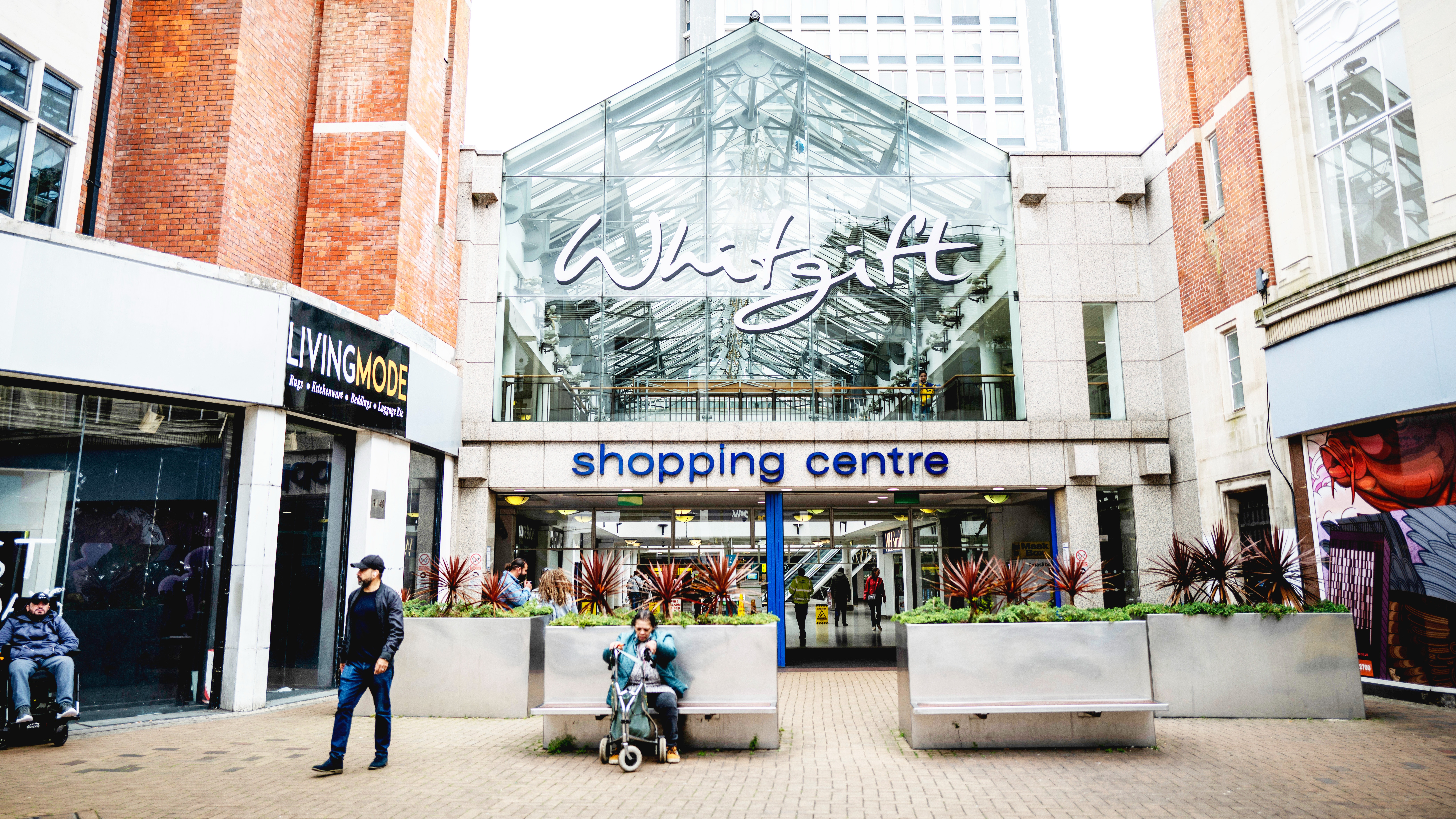
Along a short stretch of high street in Croydon, south London, it is possible to trace the collapse of British retail in less than 10 minutes.
Start at Grants: once one of the country’s grandest department stores, with dedicated sections for millinery, ribbons and lace. Those departments are still embossed proudly on the building’s listed facade, but they are long gone. Instead, Grants is now fronted by a chicken shop.
Come next to Allders: another faded department store that was shuttered in 2012 and now lies empty. With their heydays long past, vacant stores such as these now litter high streets around the country.
The next stop on Croydon’s high street is the cavernous Whitgift shopping centre, where the light pouring through the glass ceiling dapples empty floors and abandoned shop fronts, and traders worry that this might be the next domino to fall.
The anchor tenants for shopping centres like the Whitgift have traditionally been department stores, which are an increasingly threatened species in the UK. Between 2016 and 2021, 83 per cent of them closed down, according to CoStar: 467 UK stores became 79. Their disappearance now threatens to drag shopping centres under.
Landlords and local councils are scrambling to reinvent and rejuvenate hollowed out malls, which have been further ravaged by the rise of online shopping and coronavirus lockdowns. But the task is tough, demanding substantial investment at a time when falling rents and property valuations have left mall owners strapped for cash.
The Whitgift in Croydon illustrates the challenge. Big plans to redevelop the centre fell through last year with costs a factor, but not before a number of shops had closed in anticipation of the refit. That has left parts of the mall barren.
“It’s so quiet now, it’s just not worth it any more,” says one trader who has been a tenant for more than 20 years and who has chosen not to give their name because they are negotiating with the landlord to lower their rent.
Without a discount, the trader says they will probably shut up shop, adding to the casualty list of tens of thousands of retailers that have closed down in the UK over the past five years.
The long decline of in-person shopping and the slow bleed of retailers that once anchored malls begs the question: is this the end of the road for shopping centres? Or can the companies and councils that own them find a way to breathe new life into them?
“There’s no more pretending the world hasn’t changed,” says Harry Badham, in charge of development and asset repositioning at Hammerson, a co-owner of the Whitgift centre with Unibail-Rodamco-Westfield. “Frankly, anyone in any sector who denies there’s going to be change and thinks they can sit back and collect rent for 15 years is going to be mincemeat.”
From a dream to a nightmare
Vienna-born architect Victor Gruen is credited with inventing shopping centres. As US cities sprawled outwards in the 1940s and 1950s, Gruen developed a vision for covered, suburban spaces where visitors could shop, work and play without relying on cars — which he felt to be as threatening to life and health “as the great exposed sewer”.
The concept took hold, but the utopian dream was lost as developers — among them Melvin Simon, co-founder of Simon Property Group, which remains the largest mall owner in the US — realised that they could earn handsomely by relying largely or solely on retail.
The model was simple: sign up one or two anchor stores on nominal rents that would draw in customers, and then rent the space between or around them to smaller retailers who would pay for the chance to serve a captive audience.
“That became the modality in the US and UK. Retail drove out everything else in town centres,” says Mark Robinson, chair of the UK government’s High Streets Task Force and co-founder of mall investor Ellandi. “That leaves the US and UK uniquely exposed to its decline.”
The Bull Ring in Birmingham, Europe’s first indoor shopping centre, opened almost 60 years ago, promising to make shopping a “gay adventure, not an ordeal”. It was quickly imitated, and there are now more than 750 shopping centres in the UK, ranging from 20 shops and a supermarket to 1mn-square foot behemoths, according to Ellandi. The bulk are, like the Whitgift, in town centres.
The malls came with longer opening hours, a huge range of products and a sprinkling of glamour. An early advertisement for Brent Cross in north London, where fountains shot up and dispersed under an uplit, domed ceiling, gave a sense of where the new arrivals were pitching themselves: “New York, Tokyo, Paris, Milan & Brent Cross” ran the strapline.
Even as recently as five years ago, with Amazon and ecommerce well established, malls were still attracting serious interest from investors. In late 2017 and early 2018, a flurry of deals and attempted mergers signalled their belief that malls had a sustainable, even bright, future.
French company Unibail-Rodamco bought Westfield, owner of shopping centres in London and New York, in late 2017 for $25bn. The following year, Hammerson’s board rejected an offer from French mall operator Klépierre to acquire it at 635p a share, or more than £5bn. Klépierre “continues very significantly to undervalue the company”, said David Tyler, then Hammerson chair, at the time.
Today, Hammerson shares trade at 27p after a rescue rights issue in 2020, giving it a market capitalisation a little north of £1bn. Unibail-Rodamco-Westfield is selling off billions of pounds worth of European malls to bring down its debt.
Mall owners have all suffered from the wider contraction of physical retail across the UK, which has decimated their tenant base. “Going back five years we had about 290,000 shops, leaving out kiosks. We’ve lost about a third of those, about 50,000 are vacant and about 40,000 are redundant and on the way to being vacant,” says Tim Vallance, retail chair at estate agency JLL.
The demise of traditional retail has pockmarked high streets everywhere, but malls face unique challenges, not least the collapse of anchor tenants such as Philip Green’s Topshop and Debenhams during the pandemic. Designed around those anchor stores, “it’s hard to see how these inward-facing concrete monoliths could be used for anything else”, Robinson says.
In some locations, the loss of trade from office workers who are now spending more time working from home has also had an impact. The trader in Croydon’s Whitgift centre has pushed back their opening hours because office workers are no longer streaming through the centre in the morning.
All that has trapped some centres in a vicious cycle of under-investment, a far cry from the glamour and gaiety of the past.
A developer’s future
That is a challenge, but not an existential one, according to Rita-Rose Gagné, the bullish chief of Hammerson, one of the biggest owners of UK shopping centres operating today.
Appointed in September 2020, “I came into a company in lockdown”, says Gagné. Hammerson was unable to collect rent from tenants who had been forced to close by lockdown measures and the value of its assets was in freefall.
There are more straightforward jobs in property, Gagné says, but the challenge was an appealing one. “I like value creation and I knew a lot about retail investing, and when I look at this company, look at the assets, the opportunity to create that value is big.”
Value destruction, rather than creation, is the more pressing issue in the sector at the moment; Since the end of 2017, Hammerson’s shopping centres have lost almost two-thirds of their value, while average rents are down by a quarter since the end of 2018, according to rating agency Fitch.
But there are signs that the floor is close, with Hammerson’s latest results showing a 7.9 per cent drop in 2021, compared with 21 per cent in 2020.
Gagné has attempted to rein in debts and has raised about £1bn through asset sales and a rights issue. In a sign that the dirtiest work might now be done, Fitch upgraded its outlook on the company from negative to stable this month.
“We have a very clear idea of what has to be done. It’s not all do-able in 24 hours but we have already got to a point where we have delivered . . . [and] we have a lot of things in train at the moment,” says Gagné.
Having survived the immediate crisis, Hammerson issued a €700mn bond last year and can now begin to “execute”, she says. Her strategy revives some of Gruens’ original concept: melding retail together with homes, workspace and leisure facilities on the company’s sites in London, Dublin and Birmingham.
“You can have this story of ‘we create destinations’, but ultimately if you don’t have the real estate you can’t. This happens to be a portfolio of prime, urban city centre real estate,” says Gagné.
The company is also looking to adapt their malls so they are not so heavily reliant on traditional retail to draw in punters. Gagné lists wellbeing and gym facilities, cultural and sports events and last-mile logistics space as potential options.
That aim continues the evolution of malls over recent years. “Food and beverage was 5 per cent [of the tenant base] in the 1990s; that’s increased to more like 20 per cent, then [landlords have] put a cinema on top to keep people there for the evening. Then something like a climbing wall or a plinth with a car on it,” according to property analyst Mike Prew of Jefferies.
Hammerson’s peers, including Unibail-Rodamco-Westfield and Landsec, are also looking at mixed-use sites.
“The question for us is how do we maximise the value of our assets. Before, we were looking at 95 per cent as retail. Now we’re looking at the densification potential of our assets and we can do 50 per cent residential,” says Jean-Marie Tritant, chief executive of URW.
Investment, vision and luck
But reinvigorating older centres will require investment, a challenge in a cash-strapped sector that has suffered from brutal value destruction. “The big question is how you keep your properties relevant, and what the capital expenditure is to get there. Destination retail requires investment,” says Colm Lauder, an analyst at Goodbody.
Many mall owners have already made the decision to walk away. Last year, centres including the Broadmarsh in Nottingham, Elephant & Castle in London and the Chilterns in High Wycombe closed their doors for good.
So far, the few buyers to emerge for shopping centres have been opportunistic, capitalising on low values and banking what remains of the rental income. But even that is in decline, as surviving retailers are in the position to negotiate steep discounts with owners desperate to have any tenant willing to pay business rates.
Beyond rejuvenation and retirement, the third option is regeneration. Local authorities around the UK are working up schemes alongside property owners that fit declining shopping centres into wider plans to invest. The council in Stockton-on-Tees in north-east England, for example, has bought up two shopping centres and will demolish one as part of an ambitious plan to recast the high street.
With many authorities nursing budget deficits of their own and business rates income falling as a result of the demise of retail, scraping together the cash is not straightforward. “Stockton [council] has shaken everyone by the ankles” to raise the funds, according to Robinson of the High Street Task Force.
But councils have little choice but to be part of the solution, he says. “The vast majority [of shopping centres] are within town centres. There is almost a social and community imperative to do something about them. They dominate town centres and the outcome for town centres.”
In Wigan, the council has partnered with regeneration specialist Cityheart for a £135mn redevelopment of the Galleries, a shopping centre in the town centre. The remodelled mall will still include retail, but the plans also include a bowling alley, cinemas and a mini golf course, as well as almost 500 new homes. The redevelopment of the shopping centre is one of about 60 being led by local authorities nationally, says Robinson.
The Whitgift is not among them. Grand plans for a new £1.5bn mixed-use centre were drawn up by owners Unibail-Rodamco-Westfield and Hammerson alongside the council back in 2013. But those disintegrated during the pandemic.
New plans are in the works but they are likely to be piecemeal. “For years it’s been heading in one direction: talking about one big nuclear option [for redevelopment],” says Badham. Now, he adds, the conversation is about “breaking it down”.
Finding a new use for Allders is one priority — “How can you have 500,000 square feet of empty space on 150 metres of high street doing nothing?,” says Badham, hinting that the vast space could be given over to an events company.
But after decades of decline, revivifying a high street whose anchors have been hauled up will take investment, vision and some luck. Scaling back ambitions might be the way to actually make progress, Badham suggests. “The best way to eat an elephant is a bite at a time.”
Copyright The Financial Times Limited 2022







